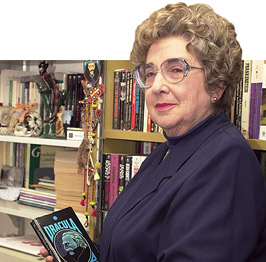
Too Ghoul for School?

Flora Zbar, ’50
In 1952, Flora Zbar was supposed to board a plane to Newark, N.J., also carrying then Secretary of State Robert P. Patterson. She got a bad feeling and decided not to take the flight. The flight crashed, killing Patterson and 29 others.
Intuition? Premonition? They are second nature to Zbar, who indulged her fascination with the occult through literature even before she was a teenager.
“I read Dracula at a very young age,” Zbar says. “I was always interested in the so-called supernormal.”
In 1970, she broke new ground when she developed one of the nation’s first college-level courses exploring supernatural occurrences in literature. Zbar pitched her idea for a course called “Literature and the Occult” to the University of South Florida, which meant she needed the approval of Florida’s Department of Education. Her proposed class attracted national and international media attention. Despite concerns that the class would teach Satanism and witchcraft, it was approved. She still teaches it today.
In addition to media attention, Zbar received letters from around the world asking all manner of questions, including how people can tell whether they are possessed or chased by a demon. But perhaps the most intriguing and gruesome inquiries have involved the police.
“They had a couple of strange murders,” Zbar says. “Someone had dug up the body of a young man and attempted to rebury it. The police contacted me wanting to know why this had been done.”
She explained to the police that bodies were sometimes exhumed to attempt resurrection, but because this body had a major physical deformity, it wasn’t suitable for the ritual.
Zbar officially retired in 2003, but she continues teaching.
“It’s been one of the more popular courses,” Zbar says. “Who isn’t really interested in ghosts or things that go bump in the night?”
—Rich Griset
White House confidential

Reggie Skinner, ’97
Reggie Skinner followed a fairly typical track after graduation—graduate school, law school, judicial clerkship, and a position as a trial attorney with the U.S. Department of Justice. Things took an unexpected turn, though, when a colleague walked into his office, shut the door, and asked, “How would you like to do a detail at the White House?”
“There are days in your life when incredible things happen to you, things you weren’t actively seeking out,” he says. “I didn’t know anyone who worked at the White House. I’d never set foot in the building. Needless to say, I snatched the opportunity up quick, fast, and in a hurry.” Soon after a vetting process he says was intense and uncomfortable, Skinner began reporting to work on Pennsylvania Avenue.
The vetting process proved to be good preparation for Skinner’s assignment—six months on a team vetting nominees for everything from obscure appointments to Cabinet-level positions. Yes, you’ve heard of some of them. But no, he can’t identify them.
At this level, candidates are by definition qualified for the job. It was up to Skinner and the vetting team to evaluate the political and reputational risks of candidates. “The point of vetting is to determine how the candidate could possibly hurt us,” he says. That meant a lot of probing personal questions into candidates’ finances, tax records, public writings, and relationships.
The process regularly put Skinner in contact with some of the most accomplished and powerful people in the world, whether it was taking photos and chatting with President Barack Obama in the Oval Office or sitting across the table from Latin pop sensation Shakira.
After vetting her for an appointment to the White House Initiative on Educational Excellence for Hispanics, Skinner met Shakira when she came to Washington for a meeting on the initiative.
“Let me tell you,” he says, “I had all sorts of street cred with the vetting team after that.”
—Kim Catley
Checking Twitter

Amanda Sullivan, ’11
Amanda Sullivan loves hockey. The Washington Capitals bonded her with two older brothers, spurred family traditions, and made her a natural fan.
“You feel an automatic connection with hockey fans, especially of your team” she says. “The community is so strong for so many fans and players. I love what it’s about.”
Unlike most fans cheering from the stands or distant sofas, Sullivan parlayed her childhood love into a job as a social media and business development coordinator for the National Hockey League.
Classmates and professors shouldn’t be surprised to find her there. She covered ice hockey for The Collegian, worked for NASCAR for a weekend, took a class on sports and society, and wrote papers about sports culture. All of that initiative landed her a marketing internship at the NHL and then the job.
“Social media is such a growing space,” Sullivan says. “In a lot of ways it’s unknown, so there’s a lot of creativity.” Half of fans live outside of their team’s geographic area, so social media is a vital way to connect with them, she says. The NHL’s Twitter account has
1.6 million followers.
Since March, Sullivan has helped manage the brands and messages of the NHL and its many corporate partners to engage with hockey fans around the country. After a 5-month lockout, the NHL is back to business as usual both on and off the ice.
The shortened season and quick sprint to June’s Stanley Cup have both the league and its teams in the spotlight.
“You just hope for the best possible storylines to develop,” Sullivan says. “It is always exciting to see what a new chapter in NHL history will bring. As a fan, there is nothing like the playoff stretch with sudden death overtimes, playoff beards, and Cinderella stories.”
—Catherine Amos, ’07


